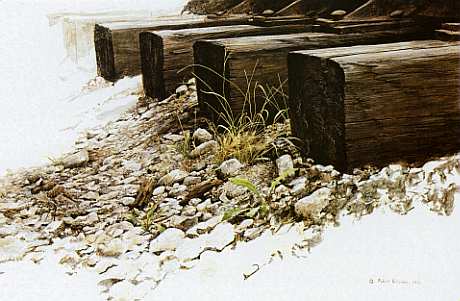|
|
Canku Ota |
|
|
(Many Paths) |
||
|
An Online Newsletter Celebrating Native America |
||
|
September 7, 2002 - Issue 69 |
||
|
|
||
|
North Dakota Place Names Tell a Story |
||
|
by Dorreen Yellow Bird Grand
Forks Herald
|
||
|
|
 My
round-trip escapades from eastern to western North Dakota can be dicey
if the weather is bad or if I get lost, but most of the time, I find being
on the road a great way to acquaint myself with places I've never been.
I always seem to get back to Grand Forks with questions. Most of the time,
they are questions about the birds or prairie. Two weeks ago as I was
driving down the middle of the state, my path led me through Anamoose. My
round-trip escapades from eastern to western North Dakota can be dicey
if the weather is bad or if I get lost, but most of the time, I find being
on the road a great way to acquaint myself with places I've never been.
I always seem to get back to Grand Forks with questions. Most of the time,
they are questions about the birds or prairie. Two weeks ago as I was
driving down the middle of the state, my path led me through Anamoose.
"Ha!" I thought. "This town was probably named because someone saw a deer, an antelope 'and a moose.'" (Incidentally, sometimes my shortcuts turn into voyages that wind up being as long as a day in the life of the Lewis and Clark expedition. A couple of months ago, that same drive took me much longer because I ended up back on U.S. Highway 2 - I missed a turn somewhere.) Anyway, I was wrong about Anamoose. But I didn't mind, because that question led me to the Internet to look for information on the places where I had traveled. The Internet wasn't as useful as a book by Douglas A. Wick, "North Dakota Place Names," which is everything you want to know about North Dakota names. Anamoose, the book says, was named by the daughter of the Soo Line railroad official. It's a corruption of the Chippewa word "uhnemoosh," meaning female dog. And the railroad seems to be an important part of this sleepy little town that sits in the middle of fields and more fields. Up the road a bit, the name changes from Chippewa to the writings of British author William Makepeace Thackery. The town of Esmond, N.D., is named for Thackery's fictional Henry Esmond. It also was an "end of the line" spot in Dakota Territory. If I take this shortcut down the middle of the state from White Shield, N.D., I turn east in Max. Now that town has an interesting and historic name: It was originally called Junction or Junction City, but the son of the postmaster was named Maximillian Freitag (Max for short), and he helped out in the post office. The young boy called it "his" post office, so it was nicknamed Max. That nickname, such as nicknames we sometime pick up over the years, stuck. Nicknames among Indian people are common. I believe most people on reservations have had one or two names that have stayed with them throughout their lives. My brother's Indian name was "Spring Colt," and we called him Pony most of his life. The nickname I grew up with was a real humdinger. Since my friends and family don't remember it, I don't tell, and it is one of the best-kept secrets on the reservation. Back to the state names: One of the most boring names in North Dakota, I think, is New Town. Now, I didn't say it was a poor name, just boring. There were Sahnish, Mandan, Hidatsa and other small communities along the river that were inundated by the building of Garrison Dam and the creation of Lake Sakakawea, and the only name for this newly created community that they could think of was New Town? Oh, well, it could have been worse. It does seem that the Native Americans influenced a lot of the names of places and towns. "Minnewaukan is the corruption of the Indian name for Devils Lake," the book says. Some Dakota speakers have told me that it means "holy water." I usually return to the four-lane Highway 2 in Devils Lake. According to the book, it originally was called Creelsburgh or also Creel City. The book also says Devils Lake is a misunderstanding by French explorers of the Indian name for the lake, Mini-waukan - again, "water and holy." After looking up some of those names, I know my next expedition will be from Underwood on state Highway 200, east up through Harvey and back to Devils Lake. All that before the snow flies and the road turns bad. Some of those little-known places in North Dakota have the friendliest people and best small restaurants. Yellow Bird writes columns. Reach her at 780-1228, (800) 477-6572 ext. 228 or dyellowbird@gfherald.com. |
|
|
||
|
|
||
| Canku Ota is a free Newsletter celebrating Native America, its traditions and accomplishments . We do not provide subscriber or visitor names to anyone. Some articles presented in Canku Ota may contain copyright material. We have received appropriate permissions for republishing any articles. Material appearing here is distributed without profit or monetary gain to those who have expressed an interest. This is in accordance with Title 17 U.S.C. section 107. | ||
|
Canku Ota is a copyright © 2000, 2001, 2002 of Vicki Lockard and Paul Barry. |
||
 |
 |
|
|
The "Canku Ota - A Newsletter Celebrating Native America" web site and its design is the |
||
|
Copyright © 1999, 2000, 2001, 2002 of Paul C. Barry. |
||
|
All Rights Reserved. |
||